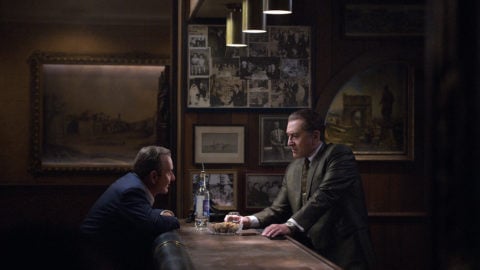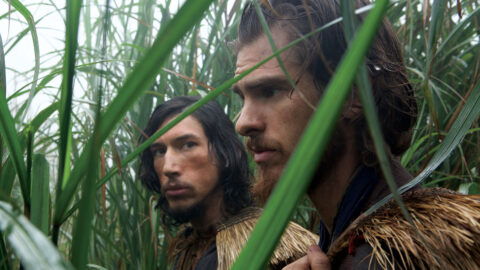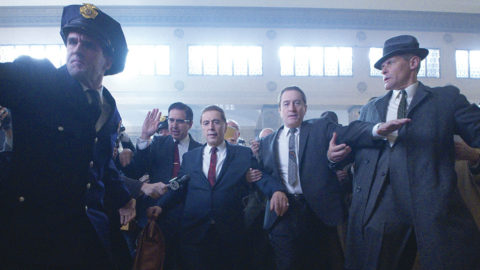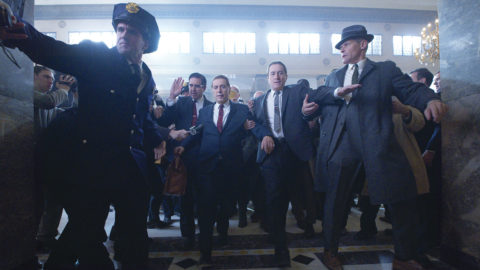Interview: Rodrigo Prieto
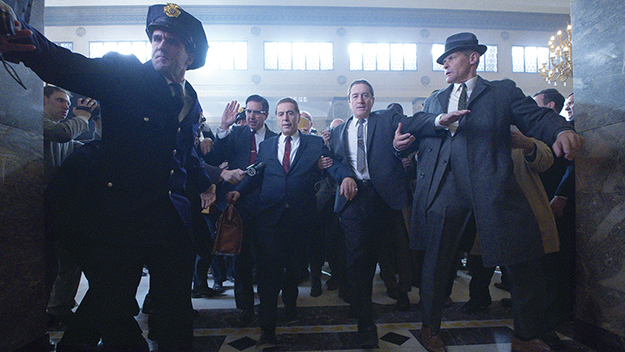
Images from The Irishman (Martin Scorsese, 2019) unless otherwise noted
For our September-October issue’s Inspired feature, I spoke with cinematographer Rodrigo Prieto about shooting The Irishman with Martin Scorsese. The two had worked together before on Silence and Wolf of Wall Street, and I was especially curious about how Prieto approached this film’s particular challenges and his conception of its complicated main character, hitman/fixer/Teamster leader Frank Sheeran. Like many audiences, he seemed still bowled over by the performances, but he also went into depth regarding the use of colors to emulate the looks of different eras and the workings of memory. He also had something to say about Peggy, Frank’s taciturn daughter, and her role in the structure of the drama. Here’s an unabridged version of our conversation.
How would you describe the story of The Irishman?
The story follows Frank Sheeran, a hit man for the Mafia. He fought in the Second World War, saw a lot of combat, a lot of death, had to do a lot of killing, and that desensitized him to it. That made him able to do killing as a job. Frank meets Russell Bufalino, the top mafia person in Philadelphia, they become good friends, and little by little, Bufalino and other mafia people start putting more trust in him. So they start asking him to do jobs for them, and little by little, that leads him to become a hit man for them. And Frank is a truck driver, so he’s in the Teamsters Union as a driver, so Bufalino introduces him to Jimmy Hoffa, and that’s the beginning of a very tight relationship. Frank starts helping Jimmy Hoffa in his endeavors in the Teamsters Union, and does some of the tough work for the Union. They were pretty strong in those days, and used some really hard tactics to get new members, to force what they needed and wanted from the government as well. So we follow that relationship of these three men as the decades and the years go by.
In prepping for the film, what was the process with Martin Scorsese?
There were a few notions that Scorsese mentioned as we were starting to prep the movie. One of them very early on was about wanting to have a feeling of the photographic memory of the past. He mentioned Super 8 or 16mm home movies, and just asked me in the general sense how I thought we could achieve that feeling without literally shooting with grainy, handheld film. So I got more into emulating the still photography look of the different decades, in particular the ’50s, and then the ’60s, and then of course a lot of the story happens in the ’70s. I decided to separate those decades with those looks, emulating those emulsions: Kodachrome in the ’50s, very saturated, and toward the ’60s we transition to Ektachrome (also saturated in color, but more a blue-green tendency).
Then for the 70s, I transitioned into a whole different look, which is not still photography: it’s ENR, a process that was developed in Technicolor by Vittorio Storaro, in which the silver is retained on the print of film for motion pictures, and the result is high contrast and desaturation of color. And then we start losing color in the ’80s, ’90s: I started applying levels of this ENR look. That gives a feel of nostalgia for the past, even though the events that are happening are not necessarily the prettiest—as the decades pass, we come to realize, just with the look of the movie, that what as going on wasn’t that great.
Scorsese talked a lot about how he wanted the job that Frank Sheeran was doing not to feel exciting. He wanted a routine sense to it, and that related mostly to the camerawork. When we see some of the killings he does, it’s not exciting or sexy. We filmed it in a relatively straightforward way, where the camera would be perpendicular to the lines. And when the camera moves, it’s very simple, basically a nodal pan: left to right, or right to left. It’s a frontal, routine way, almost like “clockwork” (a word Scorsese used). It’s simple—he does this act of violence, and goes on with his life. That created a very specific feel for the film, because we not only shot violent scenes like that, everything else has that sense as well. Of course, there are moments where there are the flourishes of Scorsese’s style with the camera, but it’s very specific moments where the camera does a strong move. It’s sparse in that sense.
Because of the span of time, we’re watching actors embody different ages. So we’re also seeing performers work at a very incredibly high level of skill.
Exactly. I think the most thrilling part of this movie is the relationship between these characters. It was mesmerizing to me, as we were filming, to witness these incredible performers working together. I think that’s a big part of the excitement of this movie.
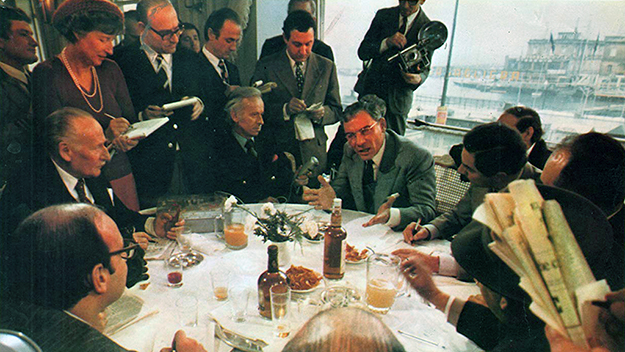
Lucky Luciano (Francesco Rosi, 1974)
Did you have any other reference points for dealing with the passing of time visually?
I don’t remember referencing movies in particular, but I do remember showing Scorsese a lot of books with photographs with these types of emulsions I’d described. I started developing ways to develop these looks, along with color scientists in London and LA and New York. It’s actually very scientific, the emulation. We went to people from Kodak to ask them exactly how they created the colors. I shot film tests, first with the stand-ins, and later with the actors in costumes with these looks applied. We tweaked them a little bit, Scorsese had notes about them—that’s how we arrived at the specific looks for the different decades.
Scorsese is such a cinephile he did mention movies that I looked at—like Lucky Luciano—just to get a sense of the era. And we saw newsreel footage of the time and of the events. So that had some influence also in the overall look.
Any particular photographers you were looking at?
A slew of them but not specific photographers I can remember—more looking at books that had Kodachrome, Ektachrome, things like that. But recently, as I’m color timing the movie, I’ve been strangely referencing Garry Winogrand. Right in Brooklyn, there’s an exhibition of his Kodachrome work, and he usually is known for his black-and-white photography, which is incredible, and I admire a lot. I used him a lot as a reference for The Irishman, more for composition and the use of lenses, the wide angle, that sort of thing. But now I saw this exhibit, so I’m using that also as I’m color timing the movie, as a reference for color.
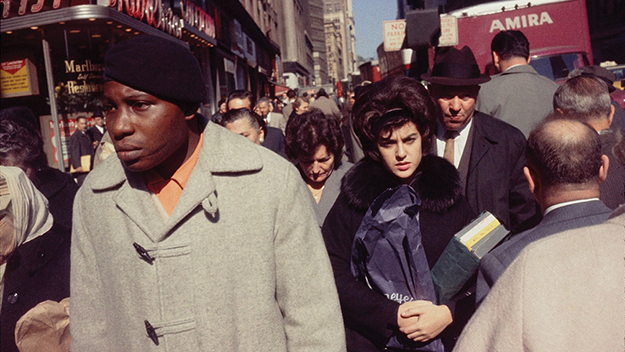
Photo by Gary Winogrand, 1965. Courtesy of the Brooklyn Museum
Everyone’s curious about the CGI process for aging their looks, and I’m trying to think of past examples of this sort of thing—The Curious Case of Benjamin Button or something like that.
I guess that would be one of the first works where something like that is done on a big scale. I think this is pioneering, because it’s not retouching. It’s not taking the face of an actor and literally Photoshopping the wrinkles out. It’s a whole new technology involving CGI, and for it, we had to develop these camera rigs that allowed the visual effects team to have the volumetric capture of the scenes. Meaning that it wasn’t just the one camera filming the angle—each angle had to include two more cameras. In essence, the main camera is shooting the shot, and the two more cameras immediately adjacent kept capturing the volume of it. But those cameras were also capturing tracking marks which were infrared, so the eye cannot see the marks—they were painted on with infrared makeup. These “witness cameras” could capture those tracking marks. When you saw the actors, it was a very faint little thing you could see on their faces.
That was a very good thing for the actors, because they felt totally free of any sort of technology. The main thing for me was coming up with the system so that these camera rigs would not be so cumbersome and dictating how we’re shooting the movie. So we had to come up with materials that were lightweight enough, and ways to connect the cameras to cables—they had to be synchronized, and not too big or too difficult to maneuver. Still, it looked weird. That’s why we called it “the three-headed monster” or “Hydra” because it was kind of monstrous. But we were able to deliver whatever shot Scorsese wanted. It was important that he didn’t feel limited. Steadicam, crane shots, anything like that. That was a challenge.
“Witness cameras” is just perfect in a movie like this.
It is perfect.
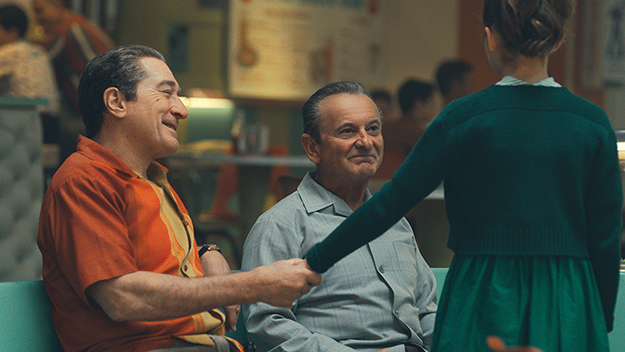
De Niro, Pacino, Pesci—you have such different and distinctive actors at work here. Do you remember how each reacted to this process?
The main thing for the actors was to perform these different ages as they’re evolving and changing as different human beings, and not only the aging, but their personality. And there is a moment when this aging stops, and it becomes just regular makeup. The characters become basically the age the actors are now. Then they become older and they have to apply prosthetic makeup. It’s really fascinating to see how these actors perform that—particularly De Niro, Pesci as well. And we had a person on set who was monitoring their body posture and helping them remember how they would walk, how they would stand at a certain age. Because the body was never really changed. The body is exactly them. So they have to feel age-appropriate.
For De Niro, we really see a big arc of decades passing. Everything about it is fascinating. His posture, the cadence of the way he talks—it’s the same character. Frank Sheeran was a pretty quiet man. He was a hermetic person, and he stuttered a little bit. And instead of being this dialogue-driven character, where you get to know him by what he says and the way he says it, it’s more about what he does and the way he does it. Or even what he doesn’t do.
There’s a moment when De Niro gets into a small airplane, and he’s going off to do something that’s horrible—even for this man, really very bad for him, emotionally. But he always has to hide these things. It’s a shot, a close-up, where he says nothing, he just sits, and this little airplane is starting to taxi, starting to take him to do this horrible thing. And just to see De Niro’s eyes was incredible. As we were shooting, it almost brought me to tears, and he’s doing nothing. He’s literally doing nothing, he’s just sitting there. But you can read into his soul. It’s just one of my favorite moments in my career to witness that.
Talking about his character made me think about film noir in the ’40s and ’50s, how they’re often about men who came back from World War II. They’re damaged in some way, and we watch how they deal with that. The Irishman almost seems related to that strain of film history. You were almost describing De Niro’s character as a worker doing a job.
That’s very accurate. It’s very much in that film noir history, not stylistically, even though there is a couple scenes here and there in that vein of film noir. Our main character couldn’t be further away from your heroic person, and what he does is very questionable. It seems like he has no remorse. But there’s his daughter, Peggy, who is the judgmental character in the movie—the one who is aware, or can see through him. And I think that through her, he gets in touch a little bit with that guilt, or that painful feeling. It’s interesting that the story utilizes other characters to focus on this main guy who would seem like he’s just doing the job and doesn’t care. But maybe he does care, maybe he doesn’t even realize, and he does care by sensing what his daughter is feeling or thinking, that his daughter is reacting in a certain way. It’s actually himself, in my view. But that’s my view.



